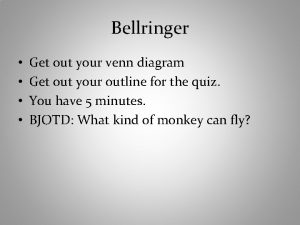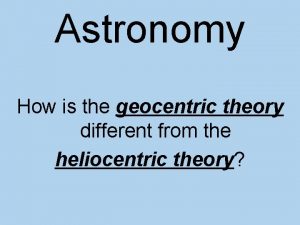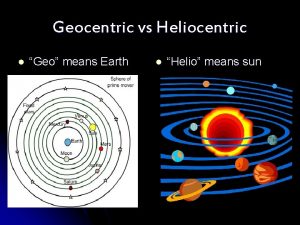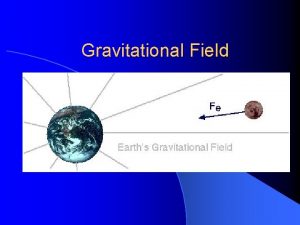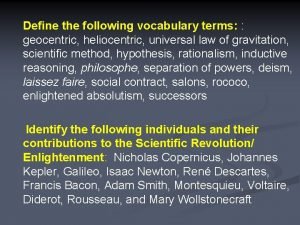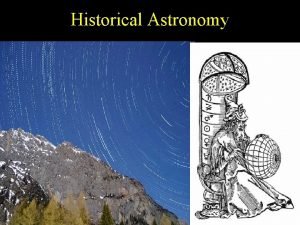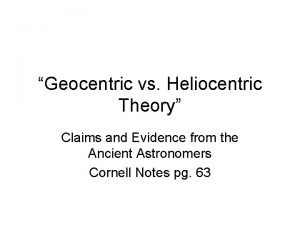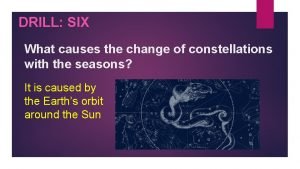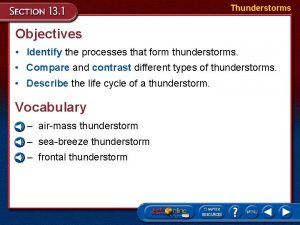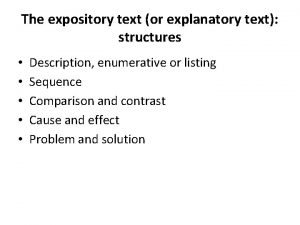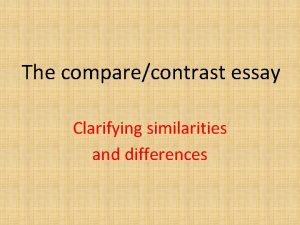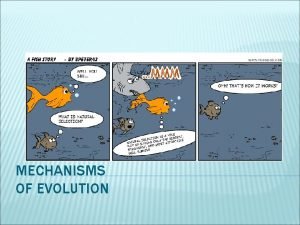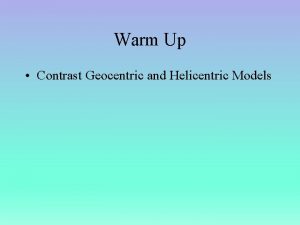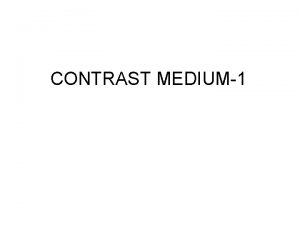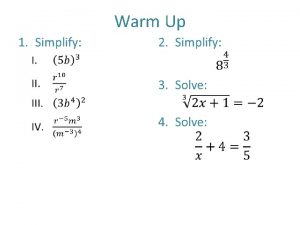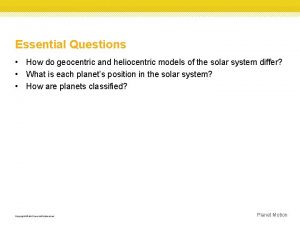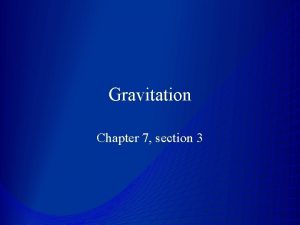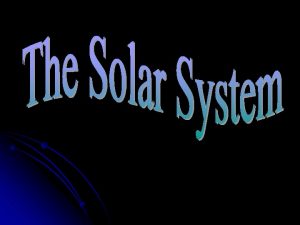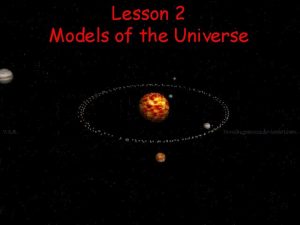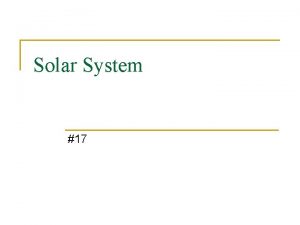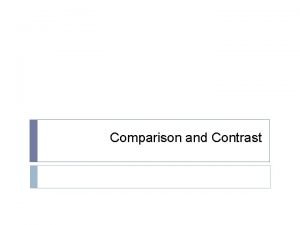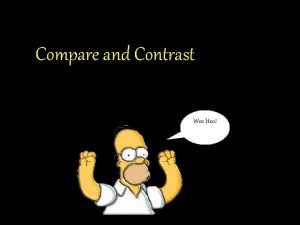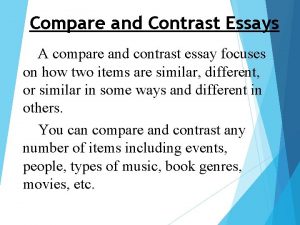Warm Up Contrast Geocentric and Helicentric Models Opening











































- Slides: 43

Warm Up • Contrast Geocentric and Helicentric Models

Opening Chapter 1 Review Questions 1. (1. 2) What causes the seasons? Seasons are Caused by the tilt of the Earths rotational axis(page 22) 2. (1. 3) What causes the Moon’s phases? The moons motion or orbit around the Earth (pages 26 27) 3. (1. 3) How long does it take the Moon to go through a cycle of phases? 29. 5 days

Opening Chapter 1 Review. Questions 4. (1. 1) If you are standing 5. (1. 1) If you observe at the Earth’s North Pole, which of the following will be directly overhead? Pg. 18 (a)The celestial equator (b)The ecliptic (c)The zodiac (d)The north celestial pole (e)The Sun Polaris to be 30° above the horizon, you are at a latitude of approximately (a) 6. 5° (b) 30° (c) 53. 5° (d) 60° (e) 83. 5°

Opening Chapter 1 Review Questions 6. For this question, choose as many answers as are correct. If the Earth reversed its direction of spin, (a) the Sun would rise in the west and set in the east. (b )the seasons would be reversed. (c ) the stars would circle Polaris clockwise. (d ) the Moon would rise in the west and set in the east. (e) the Moon would rise in the east and set in the west. 7. (1. 2) In the Northern Hemisphere, summertime is warmer than wintertime because (a)the Earth’s orbit is an ellipse. (b)the Sun is visible for more hours. (c)sunlight is more concentrated on the ground. (d)both b and c. (e)All the answers are true.

Opening Chapter 1 Review Questions 8. In which of the following locations can the length of daylight range from zero to 24 hours? (a)Only on the equator (b)At latitudes closer than 23. 5° to the equator (c)At latitudes between 23. 5° and 66. 5° north or south (d)At latitudes greater than 66. 5° north or south (e)Nowhere on Earth #8 will NOT be on test or quiz 9. (1. 3) If the Moon is waning gibbous in Chicago, then that night in Australia the Moon will be (a)waxing crescent. (b)waning gibbous (c)waxing gibbous. (d)waning crescent.

Opening Chapter 1 Review Questions 10. (1. 3) You observe the Moon rising at 6 p. m. , around sunset. Its phase is (pg. 28) (a) 1 st quarter (b) new (c) full (d )3 rd quarter 11. (1. 3) You observe the Moon rising at 3 p. m. , a few hours before sunset. Its phase is (page 28) (a) between new and first quarter. (b )between first quarter and full. (c) between full and third quarter. (d) between third quarter and new. 12. (1. 3) If you see a full moon at midnight, about how long will it be until there is a new moon? (a) 12 hours (b )3 days (c) 2 weeks (d )6 months

Study for Vocabulary Quiz tomorrow • • Star Satellite Solar system Milky way Universe Planet Galaxy • • Celestial Equator Celestial pole Celestial Sphere Precession Ecliptic Zodiac Solstice Equinox

Chapter 1(cfu) check for understanding study guide Use your text or your notes to answer the questions 1 24 complete zip grade form WORK SESSION

Chapter 1 Cycles of the Sky Copyright © Mc. Graw Hill Education. Permission required for reproduction or display.

The Celestial Sphere • Vast distances to stars prevent us from sensing their true 3 D arrangement • Naked eye observations treat all stars at the same distance, on a giant celestial sphere with the Earth at its center

Models and Science • The celestial sphere is a model, which does not necessarily match physical reality • Models provide a means to enhance our understanding of nature

Constellations • Constellations are fixed arrangements of stars that resemble animals, objects, and mythological figures • Stars in a constellation are not physically related

Appearance of Constellations over Time • Positions of stars change very slowly; constellations will look the same for thousands of years • Origin of the ancient constellations is unknown although they probably served as mnemonic tools for tracking seasons and navigation

Daily vs. Annual Motion • Daily Motion – Sun, Moon, planets, and stars rise in the east and set in the west – Due to the Earth’s rotation – Ancient astronomers took all celestial motion to be diurnal (daily) – The Celestial Sphere! • Annual Motion – “Yearly Motion” – Due to the Earth’s revolution – Is the sky different from day to day? – Month to month? – Year to year?

Daily Motion • Daily motion can be explained by the rotation of the celestial sphere about the north and south celestial poles located directly above the Earth’s north and south poles • The celestial equator, which lies directly above the Earth’s equator, provides another astronomical reference marker

Motion of Constellations • For a given time (say 10: 00 PM), as the months proceed, constellations do not appear in the same part of the sky

Annual Motion • A given star rises 3 minutes 56 seconds earlier each night • This annual motion is caused by the Earth’s motion around the Sun, the result of projection • The ancients used the periodic annual motion to mark the seasons

The Ecliptic • The path of the Sun through the stars on the celestial sphere is called the ecliptic • The ecliptic is a projection of the Earth’s orbit onto the celestial sphere and is tipped relative to the celestial equator

The Zodiac • The belt shaped region of the sky surrounding the ecliptic passes primarily through twelve constellations and is called the zodiac. • A thirteenth constellation has joined the zodiac, Ophiuchus, the snake charmer.

What Causes Seasons? • The Earth is closest to the Sun in January, which is winter in the northern hemisphere • Therefore, the seasons cannot be caused by the Sun’s proximity to the Earth • The Earth’s rotation axis is tilted 23. 5º from a line perpendicular to the Earth’s orbital plane

Axial Tilt Causes Seasons • The rotation axis of the Earth maintains nearly the same tilt (23. 5 degrees) and direction from year to year. • The northern and southern hemispheres alternate receiving (on a yearly cycle) the majority of direct light from the Sun, and longer days. • This leads to the seasons!

The Seasons

Seasons and The Ecliptic • The tilt of the Earth’s rotation axis causes the ecliptic not to be aligned with the celestial equator • Sun is above celestial equator in June when the Northern Hemisphere is tipped toward the Sun, and is below the equator in December when tipped away • Tilting explains seasonal altitude of Sun at noon, highest in summer and lowest in winter

The Ecliptic’s Tilt

Solstices and Equinoxes • Points on horizon where Sun rises and sets changes periodically throughout year • In summer months of Northern hemisphere, the Sun rises north of east and sets north of west • In winter months of Northern hemisphere, the Sun rises south of east and sets south of west • The solstices (about June 21 and December 21) are when the Sun rises at the most extreme north and south points • The equinoxes (equal day and night and about March 21 and September 23) are when the Sun rises directly east • Ancients marked position of Sun rising and setting to determine the seasons (e. g. , Stonehenge)

Sunset Directions Through the Seasons

The Sun’s Changing Position • Because the Sun moves north and south of the celestial equator during the year, the Sun does not rise due east or set due west on most days. • The shift of the Sun’s position is particularly obvious near the equinoxes, when the Sun’s position on the horizon shifts by almost its own diameter each day

The Path of the Sun Changes with Latitude • The motion of the Sun north and south in the sky over the course of the year causes the Sun to follow different paths through the sky each day as the Earth rotates. • The path the Sun follows each day can be quite different at different latitudes

The Moon • Rises in the east and sets in the west • Like the planets and Sun, the Moon moves from west to east relative to the stars (roughly the width of the Moon in one hour)

The Phases of the Moon • During a period of about 30 days, the Moon goes through a complete set of phases: new, waxing crescent, first quarter, waxing gibbous, full, waning gibbous, third quarter, waning crescent

The Phase Cycle – The phase cycle is the origin of the month (derived from the word moon) as a time period – The phases of the Moon are caused by the relative positions of the Sun, Earth, and Moon

Lunar Rise and Set Times • The Moon rises roughly 50 minutes later each day • The changing time of moonrise means that the Moon is visible at different times and places during the night or day depending on its phase.

The Sidereal Month

Eclipses • An eclipse occurs when the Sun, Earth, and Moon are directly in line with each other • A solar eclipse occurs when the Moon passes between the Sun and Earth, with the Moon casting its shadow on the Earth causing a midday sky to become dark as night for a few minutes

Solar Eclipse from Space

Solar Eclipses

Stages of a Solar Eclipse

Lunar Eclipses • A lunar eclipse occurs when the Earth passes between the Sun and Moon, with the Earth casting its shadow on the Moon giving it a dull red color

Red Moon • The Earth’s atmosphere bends some sunlight into the shadow. • The light reaching the Moon is red because interactions with particles in the air remove the blue light as it passes through our atmosphere.

Rarity of Eclipses • Because of the Moon’s tilt • Twice a year the Moon’s orbit will pass through the relative to the ecliptic, Sun giving the possibility eclipses will not occur at of an eclipse – these times every new and full Moon are called eclipse seasons

Eclipse Seasons • Since the Moon’s orbit tilts nearly in the same direction through the year, twice a year the Moon’s orbit will pass through the Sun giving the possibility of an eclipse – these times are called eclipse seasons • When a solar eclipse occurs at new Moon, conditions are right for a lunar eclipse to occur at the full Moon either before or after the solar eclipse

Eclipse Periods • Eclipses do not occur every 30 days since the Moon’s orbit is tipped relative to the Earth’s orbit • The tipped orbit allows the shadow of the Earth (Moon) to miss the Moon (Earth)

Recent and Upcoming Solar Eclipses
 The difference between heliocentric and geocentric
The difference between heliocentric and geocentric Geocentric believers
Geocentric believers Ethnocentric attitude in management
Ethnocentric attitude in management What is the difference between models and semi modals
What is the difference between models and semi modals Double contrast vs single contrast
Double contrast vs single contrast Geocentric orientation company example
Geocentric orientation company example Venn diagram of heliocentric and geocentric
Venn diagram of heliocentric and geocentric How does the geocentric model work
How does the geocentric model work West side story, romeo and juliet comparison chart
West side story, romeo and juliet comparison chart Geocentric model vs heliocentric model
Geocentric model vs heliocentric model Geocentric supporters
Geocentric supporters Eprg framework diagram
Eprg framework diagram Geocentric vs heliocentric
Geocentric vs heliocentric Define proprietary colony
Define proprietary colony Heliocentric vs geocentric venn diagram
Heliocentric vs geocentric venn diagram Who made
Who made Geocentric vs heliocentric
Geocentric vs heliocentric Facts about geocentric
Facts about geocentric Define geocentric theory
Define geocentric theory Define geocentric theory
Define geocentric theory Geocentric model
Geocentric model Heliocentric theory
Heliocentric theory Geocentric model
Geocentric model Joshua 10:13
Joshua 10:13 Geocentric theory definition world history
Geocentric theory definition world history Geocentric drilling
Geocentric drilling What was the purpose of the sibley commission
What was the purpose of the sibley commission Draw and label transverse wave
Draw and label transverse wave High tide
High tide Compare and contrast cold wave and wind chill factor
Compare and contrast cold wave and wind chill factor Compare and contrast narrative expository and explanatory
Compare and contrast narrative expository and explanatory Essay about similarities and differences
Essay about similarities and differences Compare and contrast analog and digital forecasting
Compare and contrast analog and digital forecasting Comparison words
Comparison words Most dangerous game venn diagram
Most dangerous game venn diagram Longitudinal vs transverse waves
Longitudinal vs transverse waves Compare and contrast chemical and physical changes
Compare and contrast chemical and physical changes Compare and contrast gradualism and punctuated equilibrium
Compare and contrast gradualism and punctuated equilibrium Compare and contrast macbeth and lady macbeth
Compare and contrast macbeth and lady macbeth Compare and contrast macbeth
Compare and contrast macbeth Key macbeth character quotes
Key macbeth character quotes Two vocal styles of pakistan
Two vocal styles of pakistan Eisenhower and truman compare and contrast
Eisenhower and truman compare and contrast Harry potter vs draco malfoy
Harry potter vs draco malfoy






